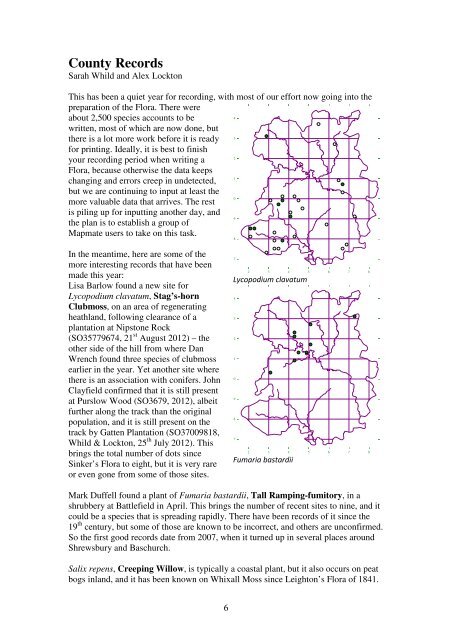Shropshire Botanical Society Newsletter - Botanical Society of the ...
Shropshire Botanical Society Newsletter - Botanical Society of the ...
Shropshire Botanical Society Newsletter - Botanical Society of the ...
Create successful ePaper yourself
Turn your PDF publications into a flip-book with our unique Google optimized e-Paper software.
County RecordsSarah Whild and Alex LocktonThis has been a quiet year for recording, with most <strong>of</strong> our effort now going into <strong>the</strong>preparation <strong>of</strong> <strong>the</strong> Flora. There wereabout 2,500 species accounts to be4written, most <strong>of</strong> which are now done, but3<strong>the</strong>re is a lot more work before it is readyfor printing. Ideally, it is best to finish2your recording period when writing aFlora, because o<strong>the</strong>rwise <strong>the</strong> data keeps1changing and errors creep in undetected,but we are continuing to input at least <strong>the</strong>0more valuable data that arrives. The restis piling up for inputting ano<strong>the</strong>r day, and9<strong>the</strong> plan is to establish a group <strong>of</strong>Mapmate users to take on this task.8In <strong>the</strong> meantime, here are some <strong>of</strong> <strong>the</strong>more interesting records that have beenmade this year:Lisa Barlow found a new site forLycopodium clavatum, Stag’s-hornClubmoss, on an area <strong>of</strong> regeneratingheathland, following clearance <strong>of</strong> aplantation at Nipstone Rock(SO35779674, 21 st August 2012) – <strong>the</strong>o<strong>the</strong>r side <strong>of</strong> <strong>the</strong> hill from where DanWrench found three species <strong>of</strong> clubmossearlier in <strong>the</strong> year. Yet ano<strong>the</strong>r site where<strong>the</strong>re is an association with conifers. JohnClayfield confirmed that it is still presentat Purslow Wood (SO3679, 2012), albeitfur<strong>the</strong>r along <strong>the</strong> track than <strong>the</strong> originalpopulation, and it is still present on <strong>the</strong>track by Gatten Plantation (SO37009818,Whild & Lockton, 25 th July 2012). Thisbrings <strong>the</strong> total number <strong>of</strong> dots sinceSinker’s Flora to eight, but it is very rareor even gone from some <strong>of</strong> those sites.72 3 4 5 6 7 8Lycopodium clavatum432109872 3 4 5 6 7 8Fumaria bastardiiMark Duffell found a plant <strong>of</strong> Fumaria bastardii, Tall Ramping-fumitory, in ashrubbery at Battlefield in April. This brings <strong>the</strong> number <strong>of</strong> recent sites to nine, and itcould be a species that is spreading rapidly. There have been records <strong>of</strong> it since <strong>the</strong>19 th century, but some <strong>of</strong> those are known to be incorrect, and o<strong>the</strong>rs are unconfirmed.So <strong>the</strong> first good records date from 2007, when it turned up in several places aroundShrewsbury and Baschurch.Salix repens, Creeping Willow, is typically a coastal plant, but it also occurs on peatbogs inland, and it has been known on Whixall Moss since Leighton’s Flora <strong>of</strong> 1841.6
















